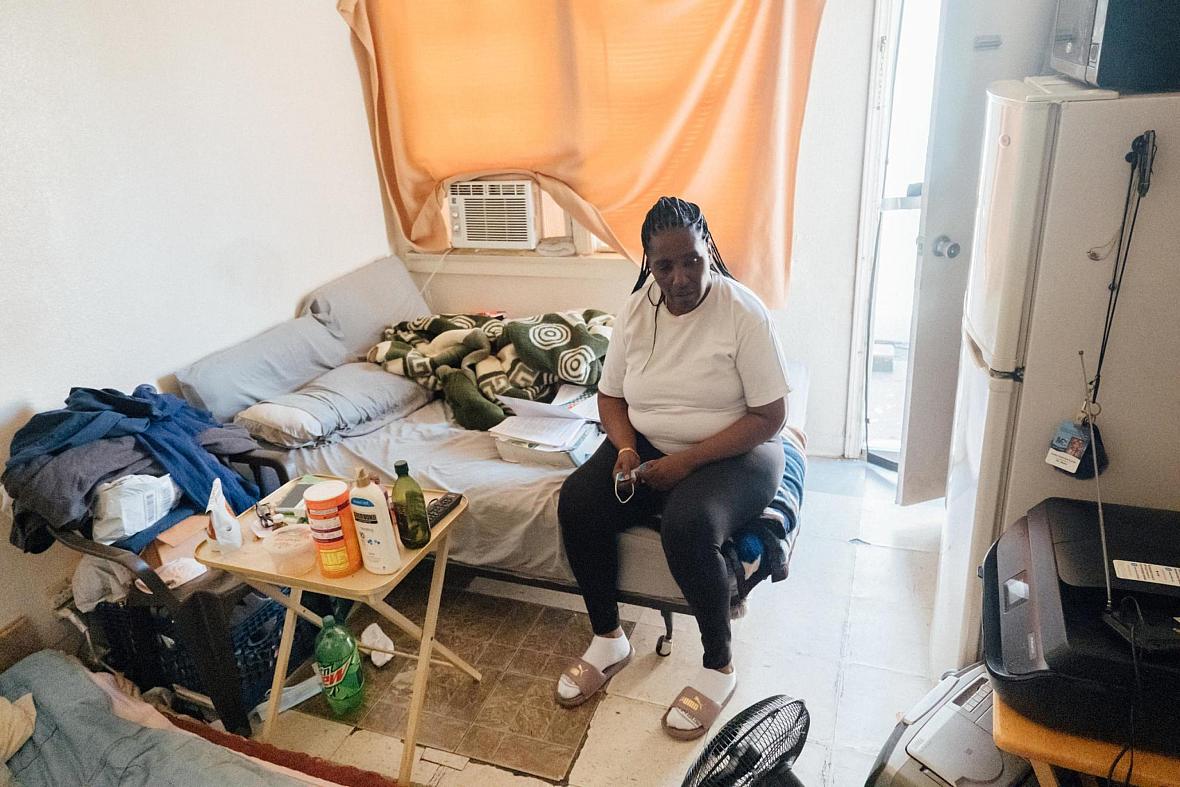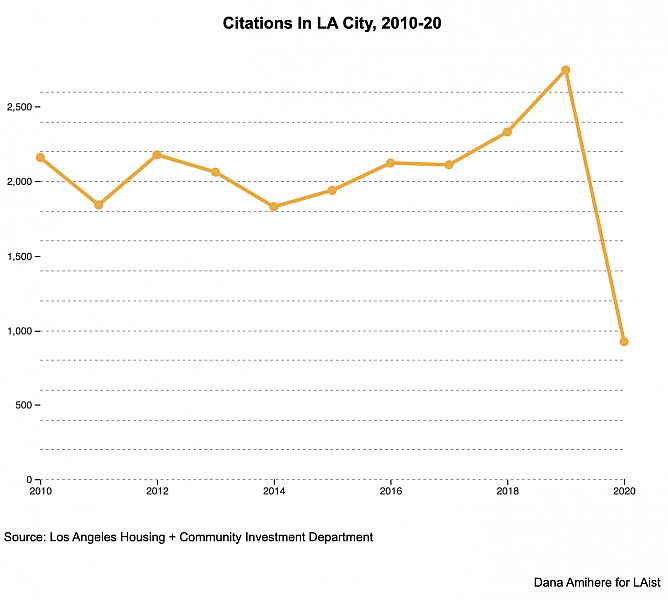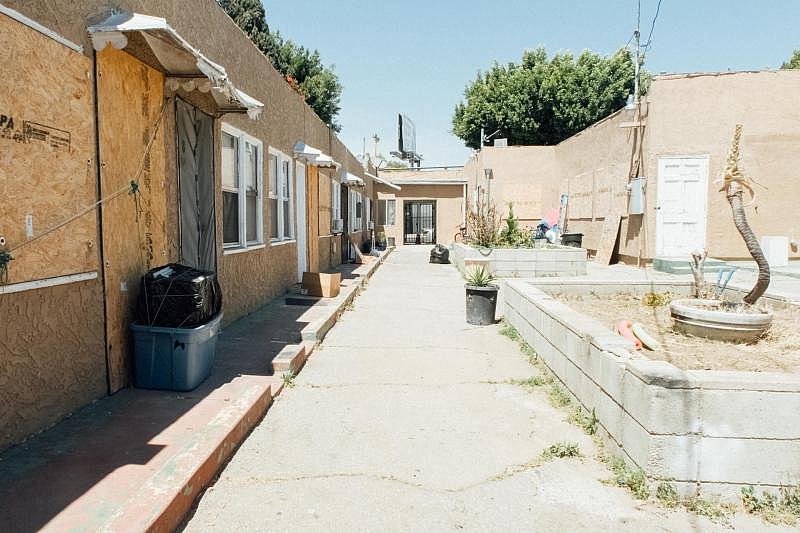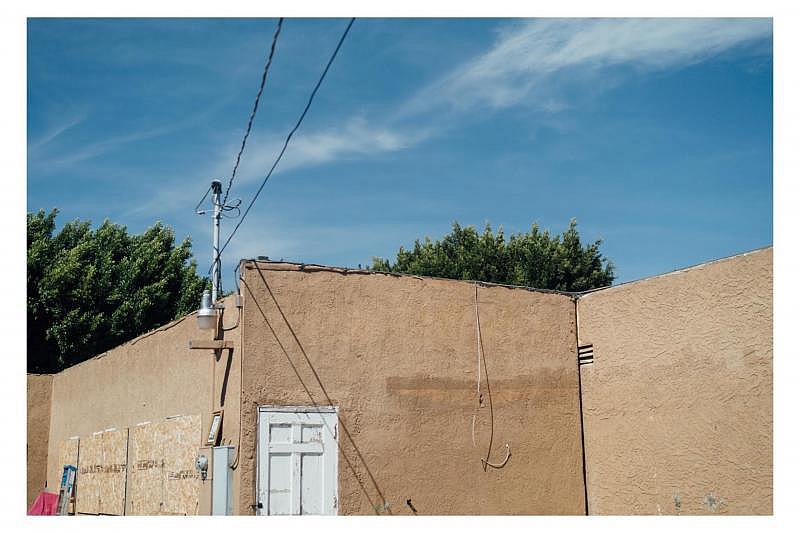Tenants Feel Stranded As LA Cuts Back On Unpermitted Housing Enforcement During The Pandemic
This is Part Two of a series on unpermitted housing by David Wagner, a 2020 Data Fellow.
His other stories include:
Part 1: Exposed Wires, Bugs, And Eviction Notices: Life In An Unpermitted LA Apartment Complex
Part 3: ‘Completely Worthless’: LA’s Program To Legalize Bootleg Apartments Falls Short

Kim Moore sits on her bed in a small unit of an unpermitted Mid-City apartment complex cited by the city in 2019 for being "substandard."
(AL KAMALIZAD / LAIST)
For many low-income Angelenos living in illegal apartments, the pandemic made chronic issues like unsafe conditions and threats of eviction even more harrowing. At the same time, city officials charged with ensuring livable housing standards have dramatically curtailed inspections and citations.
The numbers are jarring. Our analysis of L.A. city records found citations from the housing department associated with unpermitted housing plummeted by more than two-thirds in 2020 compared with the previous year.
That trend is backed up by what we heard from tenants and their advocates: That city officials have been slow or ineffective in responding to the needs of people who feel trapped in illegal housing.
In one case, Nathaly Medina, a lawyer with the Eviction Defense Network, said a client seeking relocation assistance last year to leave his unpermitted unit needed a city inspector to confirm that the unit was being rented illegally.
“Nobody would come for months,” Medina said. “He just kind of sat there in bad conditions. There wasn't a law that we could use effectively to get him what he needed.”
From 2019’s Peak To 2020’s Nosedive
To better understand the scope of illegal apartments in L.A., we obtained inspection data from the city’s Housing and Community Investment Department covering 2010 through 2020.
Our analysis focused on two types of violations: “unapproved units” and “unapproved use or occupancy.”
“Unapproved unit” violations involve buildings that include unpermitted apartments, commonly called “bootleg apartments.” For example, housing inspectors may find five units inside a building only permitted for four, because one of the units has been illegally subdivided.
The second category — “unapproved use or occupancy” — covers a wider variety of violations. It includes many examples of tenants living in spaces not meant for habitation, such as garages, closets or laundry rooms.
In many cases, this category involves a permitted apartment being used in an unpermitted way, such as small units that feature unapproved and potentially dangerous kitchen appliances. A number of violations in this category don’t involve tenants at all, such as garages being used as unpermitted storage spaces.
Counting both categories, housing department inspectors found more than 22,000 violations between 2010 and 2020. The number of annual violations peaked in 2019 at more than 2,700.
But after the coronavirus hit Los Angeles, citations took a nosedive. In 2020, the city found just 903 violations, less than one-third of 2019’s level.
Enforcement Plummeted During The Pandemic
In recent years, housing department citations related to unpermitted rental units were on the rise in the city of Los Angeles. But in 2020, in the throes of the pandemic, the number of citations sank to the lowest level in a decade.

A spokesperson with the city’s housing department said due to public health concerns, inspections were suspended from mid-March through mid-July. In December, inspections were suspended again as COVID-19 cases spiked.
During that time, “the department focused on resolving open cases,” she said.
“The safety of the field staff as well as residents was paramount,” the spokesperson said. “Inspections have since resumed while still implementing COVID-related safety protocols.”
The city’s Department of Building and Safety also routinely inspects and cites unpermitted dwelling units. COVID-19 also reduced their ability to send inspectors into people’s homes, according to spokesman Jeff Napier.
“The global pandemic severely impacted our workforce,” he said in an email. “Enforcing certain quality of life violations were suspended during this time.”
Housing rights advocates say during that period, conditions in unpermitted units often got worse.
“It seems like the ceiling has to be falling on top of you in order for them to actually do something." — Miguel Roman, tenant at an unpermitted Mid-City complex.
‘They Don’t Have Other Choices’
Despite the drop in inspections during the pandemic, city records from the past decade paint a clear picture of L.A.’s housing market: Tenants are desperate for cheaper housing, and illegal units have sprung up across the city to meet the demand.
“Unpermitted housing is very common in the city of L.A.,” said Vinit Mukhija, a UCLA professor of urban planning who has conducted research on California’s informal housing landscape.
“It is more common than many Angelenos might realize,” he said.
At this Mid-City apartment complex, tenants faced eviction threats during the pandemic. (AL KAMALIZAD / LAIST)
Mukhija estimates that around 10% of L.A.’s single family homes have an informal second unit, often in the form of an unpermitted backyard granny flat or an illegal garage conversion.
But he said the city’s informal housing comes in many other flavors: subdivided apartment buildings, parking structures turned into dwelling units, commercial spaces doubling as living quarters — just to name a few.
People end up in these units because public housing assistance is extremely limited and wages haven’t kept up with skyrocketing rents, Mukhija said.
“They don't have other choices,” he said. “If people had a choice, they would live in safe, excellent, well located housing. But in a context where they don't have choices, I suspect they're living wherever they can find housing they can afford.”
Who’s In Charge? It’s Not Always Clear
Mukhija says informal housing exists everywhere in L.A. — not just in lower-income neighborhoods.
Our analysis of city housing records found that in recent years, inspectors have uncovered large numbers of violations in parts of downtown, certain South L.A. neighborhoods, Koreatown and Boyle Heights.
Of course, some neighborhoods have more housing units in general than others, which could concentrate citations more heavily in those areas.
Many neighborhoods with higher levels of unpermitted housing citations also have lower median household incomes.
Housing rights advocates said they understood the city’s reluctance to send out inspectors during a pandemic. In many cases, tenants themselves may not want an inspector coming into their home. But they said in many cases, the lack of enforcement has left desperate tenants to fend for themselves.
“We have seen a dramatic increase in illegal lockouts and utility shutoffs,” said Trinidad Ocampo, an eviction attorney with Neighborhood Legal Services. “There has definitely been an increase in time to get inspections completed, or reports or compliance orders prepared.”
A stray wire dangles from the roof of a Mid-City apartment building cited in 2019 as "substandard." (AL KAMALIZAD / LAIST)
Experts say in the city of L.A., it’s not always clear which government agency is responsible for protecting the rights of tenants in illegal housing.
The city’s Housing and Community Investment Department routinely inspects multifamily apartment buildings, but it does not inspect illegal units attached to single family homes. That leaves many vulnerable renters outside the department’s jurisdiction.
Meanwhile, the Department of Building and Safety does inspect those units, but it only enforces physical building code violations — it doesn’t mediate tenant-landlord disputes.
“It does create this group of tenants who become particularly vulnerable, because they have no entity that can ensure that their rights are protected,” Ocampo said.
A Call To Rethink Enforcement Strategies
Whichever agency is responsible, housing advocates said the city’s current approach to enforcement won’t fix long-standing problems with illegal housing.
Pursuing criminal charges might take down some bad actors. In other cases, the city may be able to secure relocation payments for tenants in illegal units.
But with homelessness rising and affordable housing in short supply, experts said shutting down units and uprooting tenants is not the best strategy.
“Enforcement programs need to be much more holistic,” said UCLA’s Mukhija. “Their focus should be what is best for tenants, how their conditions can be improved. And if their conditions can be improved in existing units by upgrading them, that should be the avenue.”
While policymakers try to find the best approach, tenants in illegal units said they feel stranded.
Miguel Roman faced eviction threats last year in an unpermitted Mid-City apartment building cited by the city for “substandard” conditions. Even though the city has been aware of the problems for years, it hasn’t done enough to help tenants relocate, he said.
“It seems like the ceiling has to be falling on top of you in order for them to actually do something,” Roman said. “There's insects in here. There's mold everywhere. That's not enough.”
The tenants are now pursuing a lawsuit against the landlord. But pursuing relief in court can take a very long time, said Elliot Rosenberger, one of the tenants’ attorneys.
“Many lawsuits can take years to resolve — particularly now, given the effect the COVID-19 pandemic has had on the courts’ existing backlog,” he said. “In most cases, we're having trials set for one to two years after filing.”
One of Roman’s fellow tenants, Kamisha Nafarrete, said whenever the situation in their building is finally resolved, she plans to leave Los Angeles for good.
“This is my home. I grew up in California,” she said. “There's no place like this to me. I just can't afford it.”
Graphics and additional data reporting by Dana Amihere.
